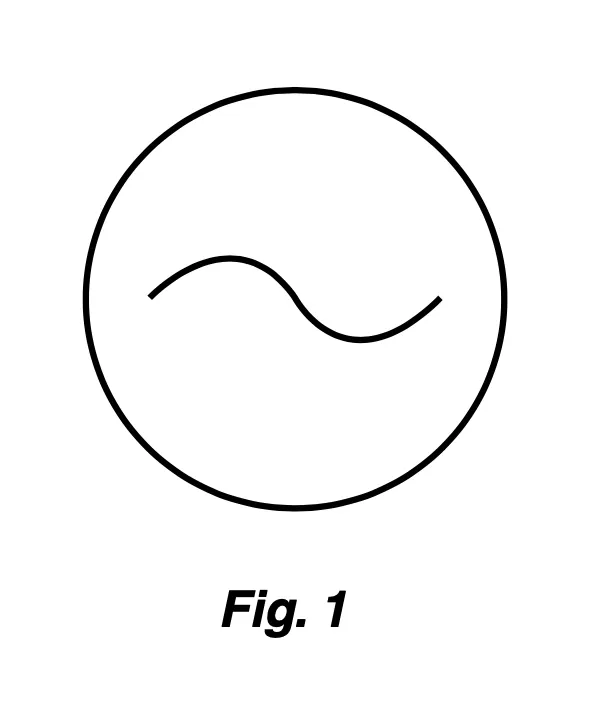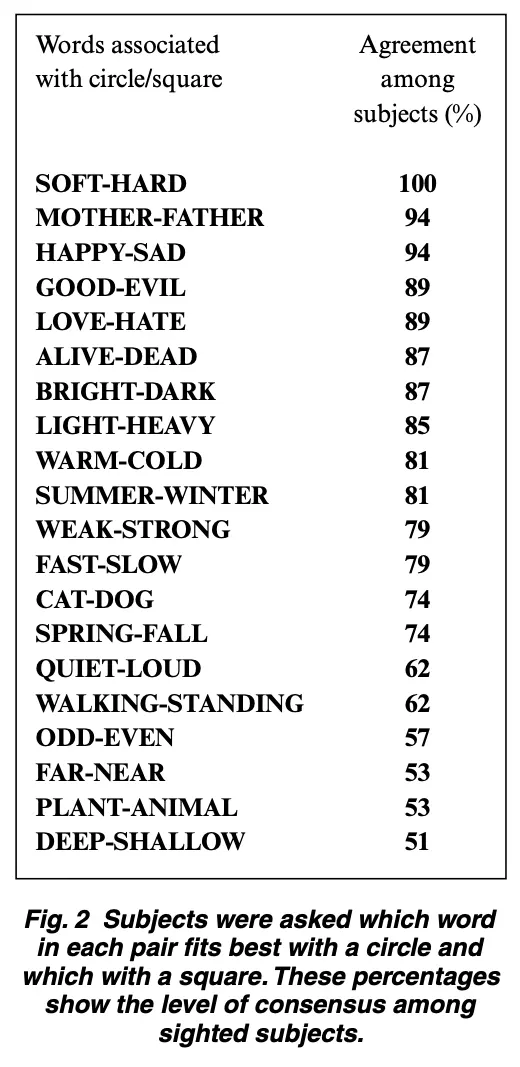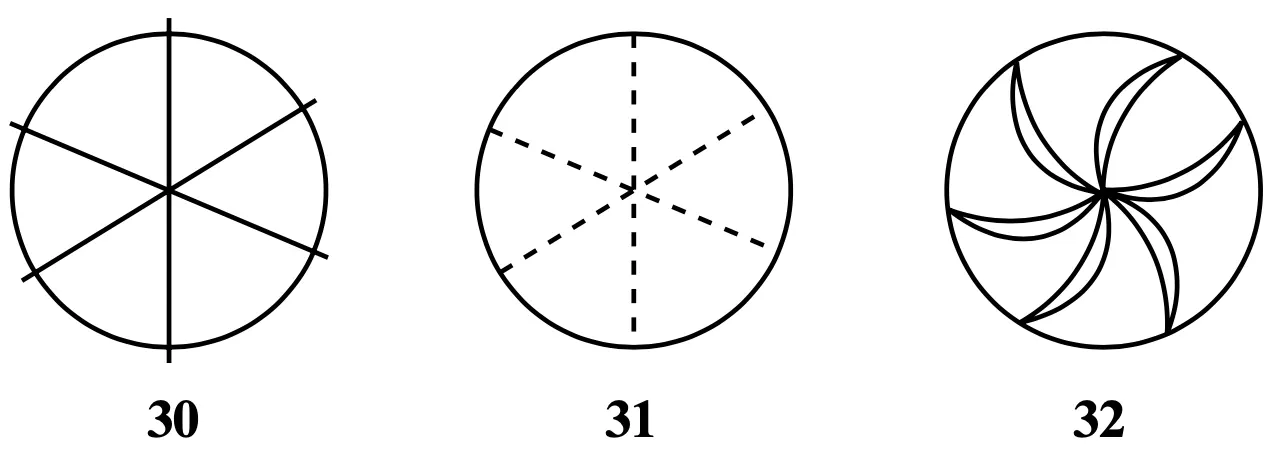در صورتی که اشکالی در ترجمه می بینید می توانید از طریق شماره زیر در واتساپ نظرات خود را برای ما بفرستید
09331464034Visual Symbols and the Blind
نماد های بصری و نابینایان

 Part 1. From a number of recent studies, it has become clear that blind people can <strong>appreciate</strong> the use of outlines and perspectives to describe the arrangement of objects and other surfaces in space.
Part 1. From a number of recent studies, it has become clear that blind people can <strong>appreciate</strong> the use of outlines and perspectives to describe the arrangement of objects and other surfaces in space.
از تعدادی از مطالعات اخیر، مشخص شده است که افراد نابینا می توانند استفاده از خطوط کلی و چشم اندازها برای توصیف آرایش اشیاء و سایر سطوح در فضا را <strong>درک</strong> کنند.
But pictures are more than <strong>literal</strong> representations.
اما تصاویر فراتر از نمایه های <strong>واقعی</strong> هستند.
This fact was drawn to my attention dramatically when a blind woman in one of my investigations decided on her own <strong>initiative</strong> to draw a wheel as it was spinning.
این واقعیت به طرز چشمگیری توجه من را جلب کرد وقتی که یک زن نابینا در یکی از تحقیقاتم با <strong>ابتکار</strong> خود تصمیم گرفت چرخی را هنگامی که درحال چرخش بود به تصویر بکشد.
To show this motion, she traced a <strong>curve</strong> inside the circle (Fig. 1).
برای نشان دادن این حرکت، او یک <strong>منحنی</strong> را در داخل دایره ترسیم کرد.
<strong>I was</strong> <strong>taken aback</strong>.
<strong>جا خوردم</strong>.
Lines of motion, such as the one she used, are a very recent invention in the history of <strong>illustration</strong>.
خطوط حرکتی، مانند همان هایی که او استفاده کرده بود، یک اختراع بسیار اخیر در تاریخ <strong>تصویرگری</strong> است.
Indeed, as art scholar David Kunzle notes, Wilhelm Busch, a <strong>trend-setting</strong> nineteenth-century cartoonist, used virtually no motion lines in his popular figures until about 1877.
در واقع، همانطور که محقق هنری دیوید کانزل ذکر می کند، ویلهلم بوش، <strong>رواج دهنده</strong> کاریکاتوریست در قرن نوزدهم، تقریباً تا سال 1877 از هیچ خط حرکتی در تصاویر مشهورش استفاده نکرد.
<strong> </strong>
When I asked several other blind study subjects to draw a spinning wheel, one particularly clever rendition appeared repeatedly: several subjects showed the <strong>wheel's spokes</strong> as curved lines.
وقتی از چند نابینای دیگر که موضوع آزمایش بودند خواستم یک چرخ در حال چرخش بکشند، یک اجرای کاملاً هوشمندانه بارها و بارها ظاهر شد: چندین نفر <strong>پره های چرخ</strong> را به صورت خطوط منحنی نشان می دادند.
When asked about these curves, they all described them as <strong>metaphorical</strong> ways of suggesting motion.
وقتی از آنها در مورد این منحنی ها سوال شد، همه آنها را به عنوان روشهای <strong>استعاره ای</strong> برای نشان دادن حرکتی که خواسته شده بود توصیف کردند.
<strong>Majority</strong> rule would argue that this device somehow indicated motion very well.
قانون <strong>اکثریت</strong> استدلال می کند که این شیوه به نوعی حرکت را به خوبی نشان می دهد.
But was it a better <strong>indicator</strong> than, say, broken or wavy lines - or any other kind of line, for that matter? The answer was not clear.
اما آیا این <strong>شاخص</strong>، برای مثل، بهتر از خطوطه شکسته یا موج دار - یا هر نوع خط دیگری برای این موضوع بود؟ جواب واضح نبود.
So I decided to test whether various lines of motion were <strong>apt</strong> ways of showing movement or if they were merely idiosyncratic marks.
بنابراین تصمیم گرفتم آزمایش کنم که آیا خطوط حرکتی مختلف روشهای <strong>مناسبی</strong> برای نشان دادن حرکت بودند یا اینکه صرفاً علائمی بودند که از افکار شخصی سرچشمه میگرفتند.
<strong>Moreover</strong>, I wanted to discover whether there were differences in how the blind and the sighted interpreted lines of motion.
<strong>به علاوه</strong>، من می خواستم کشف کنم که آیا تفاوت هایی در نحوه تفسیر نابینایان و بینایان از خطوط حرکتی وجود دارد؟
<strong> </strong>
To search out these answers, I created <strong>raised</strong>-line drawings of five different wheels, depicting spokes with lines that curved, bent, waved, dashed and extended beyond the perimeter of the wheel.
برای جستجوی این پاسخ ها، من نقش های <strong>برجسته</strong> از پنج چرخ مختلف ایجاد کردم، که پره هایی را با خطوطی نشان می دهد که منحنی، خم شده، موج دار، منقطع شده و در پیرامون چرخ چرخیده اند.
I then asked eighteen blind volunteers to feel the wheels and assign one of the following motions to each wheel: <strong>wobbling</strong>, spinning fast, spinning steadily, jerking or braking.
سپس از هجده داوطلب نابینا خواستم که چرخ ها را لمس کرده و یکی از حرکات: <strong>لرزیدن</strong>، سریع چرخیدن، چرخیدن با سرعت ثابت، لرزیدن یا ترمز کردن را به هر چرخ اختصاص دهند.
My control group consisted of eighteen sighted <strong>undergraduates</strong> from the University of Toronto.
گروه کنترل من متشکل از هجده <strong>دانشجوی کارشناسی</strong> بینای دانشگاه تورنتو بود.
<strong> </strong>
All but one of the blind subjects <strong>assigned</strong> distinctive motions to each wheel.
به جز یکی از افراد نابینا بقیه حرکت های مشخصی را به هر چرخ <strong>اختصاص دادند</strong>.
Most guessed that the curved spokes indicated that the wheel was spinning steadily; the wavy spokes, they thought, suggested that the wheel was wobbling; and the bent spokes were taken as a sign that the wheel was <strong>jerking</strong>.
بیشتر حدس می زدند که پره های خمیده نشان دهنده این است که چرخ با سرعت ثابت می چرخد؛ آنها فکر کردند، که پره های موج دار، چرخ لرزان است؛ و پره های خم شده به عنوان نشانه <strong>تکان خوردن</strong> چرخ در نظر گرفته شدند.
Subjects assumed that spokes extending beyond the wheel's perimeter signified that the wheel had its brakes on and that <strong>dashed</strong> spokes indicated the wheel was spinning quickly.
افراد گمان می کردند که پره هایی که فراتر از محیط چرخ قرار دارند نشان دهنده این هستند که چرخ ترمز گرفته و پره های <strong>منقطع</strong> نشان می دهد که چرخ در حال سریع چرخیدن است.
<strong> </strong>
In addition, the favoured description for the sighted was the favoured description for the blind in every <strong>instance</strong>.
بعلاوه، توصیف مورد پسند بینایان در هر <strong>نمونه</strong> توصیف مورد پسند نابینایان نیز بود.
What is more, the <strong>consensus</strong> among the sighted was barely higher than that among the blind.
چه بسا اینکه، <strong>اتفاق نظر</strong> بین بینایان به سختی بیشتر از بین نابینایان بود.
Because motion devices are unfamiliar to the blind, the <strong>task</strong> I gave them involved some problem solving.
از آنجا که شیوه های حرکتی برای نابینایان ناآشنا هستند، <strong>وظیفه</strong> ای که به آنها سپردم شامل حل برخی از مسائل میشد.
Evidently, however, the blind not only figured out meanings for each line of motion, but as a group they generally came up with the same meaning at least <strong>as frequently as</strong> did sighted subjects.
با این حال، از قرار معلوم، نابینایان نه تنها معانی هر خط حرکتی را تحلیل و کشف کردند، بلکه به عنوان یک گروه به طور مشابه یا حداقل <strong>به همان میزان </strong>که افراد بینا به همان معنی رسیدند، به همان مفهوم کلی رسیدند.
<strong> </strong>
Part2. We have found that the blind understand other kinds of visual metaphors as well.
ما دریافتیم که نابینایان انواع دیگر استعاره های بصری را نیز درک می کنند.
One blind woman drew a picture of a child inside a heart - choosing that symbol, she said, to show that love surrounded the child.
یک زن نابینا تصویری از یک کودک را در درون یک قلب کشید - به گفته او، این نماد را انتخاب کرد تا نشان دهد عشق کودک را احاطه کرده.
With Chang Hong Liu, a doctoral student from China, I have begun <strong>exploring</strong> how well blind people understand the symbolism behind shapes such as hearts that do not directly represent their meaning.
من با چانگ هونگ لیو، دانشجوی دکترا از چین، شروع به <strong>کاوش</strong> در مورد چگونگی درک خوب افراد نابینا از نمادین بودن شکل هایی مانند قلب که به طور مستقیم معنی آنها را نشان نمی دهند، کردم.
<strong> </strong>
We gave a list of twenty pairs of words to sighted subjects and asked them to pick from each pair the <strong>term</strong> that best related to a circle and the term that best related to a square.
ما لیستی از بیست جفت کلمه به افراد بینا ارائه دادیم و از آنها خواستیم که <strong>اصطلاحات</strong> مربوط به یک دایره و اصطلاحات مربوط به مربع را از هر جفت انتخاب کنند.
For example, we asked: What goes with soft? A circle or a square? Which <strong>shape</strong> goes with hard?
به عنوان مثال ، ما پرسیدیم: چه شکلی با {واژه} نرم همراه میشود؟ دایره یا مربع؟ کدام <strong>شکل</strong> با سخت همراه می شود؟
All our subjects deemed the circle soft and the square hard.
همه سوژه های ما دایره را نرم و مربع را سخت می دانستند.
A full 94% <strong>ascribed</strong> happy to the circle, instead of sad.
94٪ کامل به جای غمگین ، خوشحالی را به دایره <strong>نسبت دادند</strong>.
But other pairs revealed less agreement: 79% <strong>matched</strong> fast to slow and weak to strong, respectively.
اما دیگر جفت ها توافق کمتری نشان دادند: 79٪ به ترتیب، از سریع را به آهسته و ضعیف را به قوی <strong>مرتبط دانستند</strong>.
And only 51% <strong>linked</strong> deep to circle and shallow to square (Fig. 2).
و فقط 51٪ عمقی بودن را به دایره و سطحی بودن را به مربع <strong>نسبت</strong> دادند.
When we tested four totally blind volunteers using the same list, we found that their choices closely <strong>resembled</strong> those made by the sighted subjects.
هنگامی که چهار داوطلب کاملا نابینا را با استفاده از همان شیوه آزمایش کردیم، متوجه شدیم که انتخاب آنها <strong>شباهت</strong> زیادی به انتخاب افراد بینا دارد.
One man, who had been blind since birth, scored <strong>extremely</strong> well.
یک مرد، که از بدو تولد نابینا بود، امتیاز <strong>بسیار</strong> خوبی کسب کرد.
He made only one match differing from the consensus, assigning 'far' to <strong>square</strong> and 'near' to circle.
او فقط یک مورد متفاوت با نظر اتفاق شده داشت، او "دور" را به <strong>مربع</strong> و "نزدیک" را به دایره اختصاص داده بود.
In <strong>fact</strong>, only a small majority of sighted subjects - 53% - had paired far and near to the opposite partners.
در <strong>حقیقت</strong>، فقط جمعیت کمی از افراد بینا - 53٪ - دور و نزدیک را به یار های مخالف نسبت داده بودند.
Thus, we concluded that the blind interpret <strong>abstract</strong> shapes as sighted people do.
از این رو، نتیجه گرفتیم که نابینایان اشکال <strong>انتزاعی</strong> را همانطور که افراد بینا تفسیر می کنند، تفسیر می کنند.
Questions & answers
Questions 27 –29
Choose the correct letter, A, B, C or D.
Write your answers in boxes 27 –29 on your answer sheet.
27 In the first paragraph, the writer makes the point that blind people
A. may be interested in studying art.
B. can draw outlines of different objects and surfaces.
C. can recognise conventions such as perspective.
D. can draw accurately.
28 The writer was surprised because the blind woman
A. drew a circle on her own initiative.
B. did not understand what a wheel looked like.
C. included a symbol representing movement.
D. was the first person to use lines of motion.
29 From the experiment described in Part 1, the writer found that the blind subjects
A. had good understanding of symbols representing movement.
B. could control the movement of wheels very accurately.
C. worked together well as a group in solving problems.
D. got better results than the sighted undergraduates.
Questions 30 –32
Look at the following diagrams (Questions 30 –32), and the list of types of movement below. Match each diagram to the type of movement A–E generally assigned to it in the experiment. Choose the correct letter A–E and write them in boxes 30–32 on your answer sheet.

A steady spinning
B jerky movement
C rapid spinning
D wobbling movement
E use of brakes
Questions 33 –39
Complete the summary below using words from the box. Write your answers in boxes 33 –39 on your answer sheet. NB You may use any word more than once.
In the experiment described in Part 2, a set of word 33.......…… was used to investigate whether blind and sighted people perceived the symbolism in abstract 34.....…...… in the same way. Subjects were asked which word fitted best with a circle and which with a square. From the 35...…...… volunteers, everyone thought a circle fitted ‘soft ’while a square fitted ‘hard’. However, only 51% of the 36.......…… volunteers assigned a circle to 37.....…… . When the test was later repeated with 38...…...… volunteers, it was found that they made 39...…...… choices.
|
associations blind deep hard hundred identical pairs shapes sighted similar shallow soft words |
Question 40
Choose the correct letter A, B, C or D. Write your answer in box 40 on your answer sheet.
Which of the following statements best summarises the writer ’s general conclusion?
A The blind represent some aspects of reality differently from sighted people.
B The blind comprehend visual metaphors in similar ways to sighted people.
C The blind may create unusual and effective symbols to represent reality.
D The blind may be successful artists if given the right training.
Answers:
27. C
28. C
29. A
30. E
31. C
32. A
33. pairs
34. shapes
35. sighted
36. sighted
37. deep
38. blind
39. similar
40. B
نظرات کاربران
هنوز نظری درج نشده است!